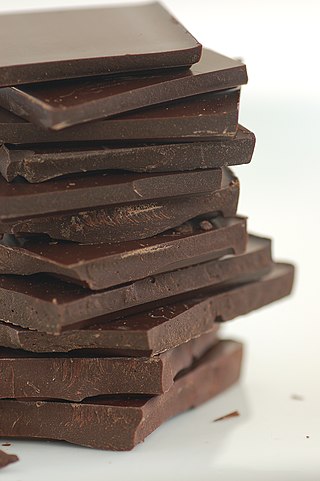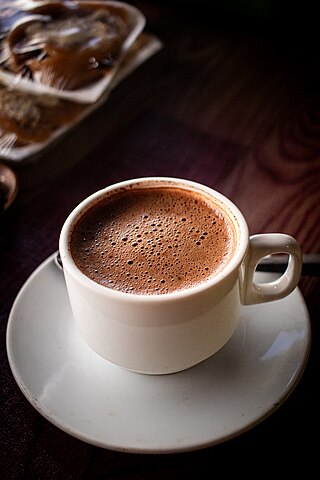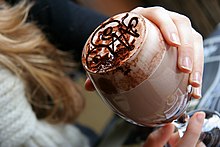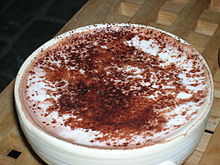
Chocolate or cocoa is a food made from roasted and ground cacao seed kernels that is available as a liquid, solid, or paste, either on its own or as a flavoring agent in other foods. Cacao has been consumed in some form for at least 5,300 years starting with the Mayo-Chinchipe culture in what is present-day Ecuador and later Mesoamerican civilizations also consumed chocolate beverages before being introduced to Europe in the 16th century.

Dessert is a course that concludes a meal. The course consists of sweet foods, such as cake, biscuit, ice cream and possibly a beverage such as dessert wine and liqueur. Some cultures sweeten foods that are more commonly savory to create desserts. In some parts of the world there is no tradition of a dessert course to conclude a meal.

A drink or beverage is a liquid intended for human consumption. In addition to their basic function of satisfying thirst, drinks play important roles in human culture. Common types of drinks include plain drinking water, milk, juice, smoothies and soft drinks. Traditionally warm beverages include coffee, tea, and hot chocolate. Caffeinated drinks that contain the stimulant caffeine have a long history.

A cappuccino is an espresso-based coffee drink that is traditionally prepared with steamed milk including a layer of milk foam.

The cocoa bean or simply cocoa, also called cacao, is the dried and fully fermented seed of Theobroma cacao, the cacao tree, from which cocoa solids and cocoa butter can be extracted. Cocoa trees are native to the Amazon rainforest. They are the basis of chocolate and Mesoamerican foods including tejate, an indigenous Mexican drink.

Chocolate milk is sweetened chocolate-flavored milk. It can be made by mixing chocolate syrup with milk. It can be purchased pre-mixed with milk or made at home by blending milk with cocoa powder and a sweetener, melted chocolate, chocolate syrup, or a pre-made powdered chocolate milk mix. Other ingredients, such as starch, salt, carrageenan, vanilla, or artificial flavoring are sometimes added.

Milk chocolate is a form of solid chocolate containing cocoa, sugar and milk. It is the most consumed type of chocolate, and is used in a wide diversity of bars, tablets and other confectionery products. Milk chocolate contains smaller amounts of cocoa solids than do dark chocolates, and contains milk solids. While its taste has been key to its popularity, milk chocolate was historically promoted as a healthy food, particularly for children.

A chocoholic is a person who craves or compulsively consumes chocolate. The word "chocoholic" was first used in 1968, according to Merriam-Webster. It is a portmanteau of "chocolate" and "alcoholic". The term is used loosely or humorously to describe a person who is inordinately fond of chocolate; however, there is medical evidence to support the existence of actual addiction to chocolate. Psychoactive constituents of chocolate that trigger a ‘feel-good’ reaction for the consumer include tryptophan and phenylethylamine, which may contribute to cravings and addiction-like responses, particularly in people with specific genetic alleles. The quantity of sugars used in chocolate confections also impacts the psychoactive effects of chocolate.

Raw chocolate, or raw ground chocolate paste when ground, is chocolate produced from cocoa beans that does not contain any additives like sugars.

A caffè mocha, also called mocaccino, is a chocolate-flavoured warm beverage that is a variant of a caffè latte, commonly served in a glass rather than a mug. Other commonly used spellings are mochaccino and also mochachino. The name is derived from the city of Mokha, Yemen, which was one of the centres of early coffee trade. Like latte, the name is commonly shortened to just mocha.

A kopitiam or kopi tiam is a type of coffee shop mostly found in parts of Indonesia, Malaysia, Singapore, Brunei and Southern Thailand patronised for meals and beverages, and traditionally operated by the Chinese community of these countries. The word kopi is an Indonesian and Malay term for coffee and tiam is the Hokkien/Hakka term for shop. Traditional kopitiam menus typically feature simple offerings: a variety of foods based on egg, toast, kaya, plus coffee, tea, Horlicks and Milo. Modern kopitiams typically feature multiple food stalls that offer a wider range of foods.

A Konditorei is a business that typically offers a wide variety of pastries and typically also serves as a café. Konditoreien (plural) are found in many countries including but not limited to Germany, Austria, Switzerland, France, Denmark, Sweden, and the Czech Republic. In French-speaking countries, similar businesses are referred to as pâtisseries.

Chocolate is a food product made from roasted and ground cocoa pods mixed with fat and powdered sugar to produce a solid confectionery. There are several types of chocolate, classified primarily according to the proportion of cocoa and fat content used in a particular formulation.

The history of chocolate dates back over 5,000 years. The cacao tree is native to the tropics of the Americas. The cocoa bean was first domesticated at least 5,300 years ago in what is present-day southeast Ecuador by the Mayo-Chinchipe culture, before being introduced in Mesoamerica. Originally prepared as a drink, chocolate was served as a bitter liquid, mixed with spices or corn puree. In Mesoamerica, it was believed to be an aphrodisiac and to give the drinker strength. Today, such drinks are also known as "Chilate" and are made by locals in the south of Mexico and the north triangle of Central America. After its arrival to Europe in the sixteenth century, sugar was added to it and it became popular throughout society, first among the ruling classes and then among the common people. In the 20th century, chocolate was considered essential in the rations of United States soldiers during war.
The following outline is provided as an overview of and topical guide to chocolate:
The chocolate industry in the Philippines developed after introducing the cocoa tree into Philippine agriculture. The growing of cacao or cocoa boasts a long history stretching from the colonial times. Originating from Mesoamerican forests, cacao was first introduced by the Spanish colonizers four centuries ago. Since then the Philippine cocoa industry has been the primary producer of cocoa beans in Southeast Asia. There are many areas of production of cacao in the Philippines, owing to soil and climate. The chocolate industry is currently on a small to medium scale.

Tsokolate, also spelled chocolate, is a native Filipino thick hot chocolate drink. It is made from tabliya or tablea, tablets of pure ground roasted cacao beans, dissolved in water and milk. Like in Spanish and Mexican versions of hot chocolate, the drink is traditionally made in a tsokolatera and briskly mixed with a wooden baton called the molinillo, causing the drink to be characteristically frothy. Tsokolate is typically sweetened with a bit of muscovado sugar, and has a distinctive grainy texture.
Breakfast, the first meal of the day eaten after waking from the night's sleep, varies in composition and tradition across the world.





























